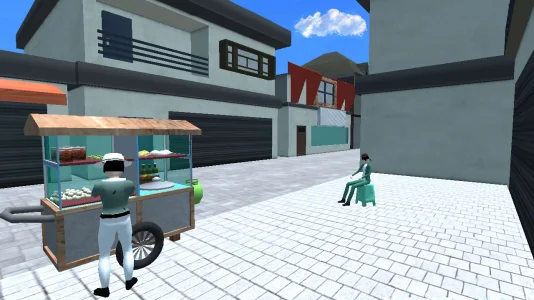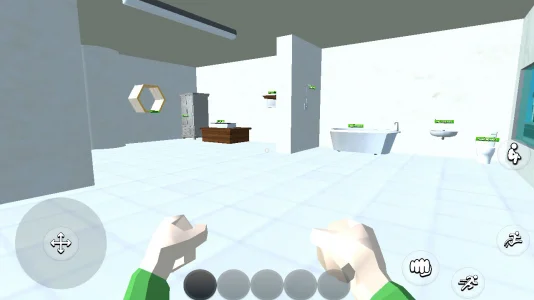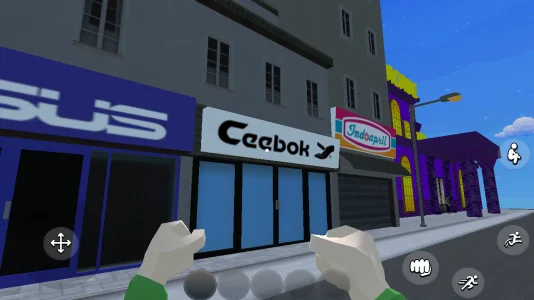Download Bakso Simulator MOD New Update
*Bakso Simulator* is an independent video game developed by the Indonesian studio Akhir Pekan Studio. The game is a first-person simulation that combines business management with open-world adventure and life-simulation elements. In the game, players assume the role of an entrepreneur tasked with building a successful street food business centered on bakso, a traditional Indonesian meatball soup. This involves managing a food cart, serving customers, exploring a town to complete quests, and protecting the business from various threats.
Screenshots



About This Game
An In-Depth Analysis of Bakso Simulator
Bakso Simulator is an independent video game developed and published by the Indonesian-based Akhir Pekan Studio. This title presents a first-person simulation experience that places the player into the role of a budding entrepreneur managing a street food business. The game’s central theme revolves around bakso, a popular Indonesian meatball soup, but its mechanics extend far beyond simple food service. It functions as a multifaceted hybrid, integrating core elements of business management simulation with the exploratory freedom of an open-world adventure and life-simulation game, complete with a distinct narrative and character-driven quests.Development, Release, and Platform Availability
The development trajectory of Bakso Simulator aligns with modern indie game release cycles. The title first launched in Early Access on the PC platform Steam in June 2022, followed by its full release in October 2022. This phased release allowed Akhir Pekan Studio to refine the gameplay and address technical issues based on player feedback. Concurrently, the game was released on mobile platforms around June 2022, establishing its presence on Android and iOS. This multi-platform availability makes Bakso Simulator accessible to a broad audience, although the gameplay experience, particularly concerning its monetization model, differs significantly between the PC and mobile versions.Core Gameplay Mechanics and World Design
Bakso Simulator distinguishes itself within the simulation genre by weaving multiple gameplay systems into a cohesive experience. The game is not merely a restaurant simulator but a comprehensive simulation of a small business owner's life, incorporating daily routines, emergent challenges, and long-term strategic objectives. The gameplay design rests on three foundational pillars: business management, open-world exploration, and personal life simulation, which together create a dynamic and engaging loop.The Day-to-Day Operation: Managing Your Bakso Cart
The fundamental gameplay operates on a day-and-night cycle, which establishes the primary routine for the player. Each day begins with the player character's business partner, an NPC known as "Bakso Man," moving the food cart from the player's house to its designated spot in town. The business opens at 8:00 AM, with Bakso Man automatically handling all food preparation. The player's role is managerial and logistical. Core responsibilities include setting up tables and chairs, ensuring the cart is stocked with ingredients and gas, serving drinks to customers, and collecting payments. As the business progresses, players can invest earnings into better furniture to increase customer patience and improve the restaurant's rating, which in turn attracts higher-paying clientele. The business day concludes around 7:00 PM, and the player must return home to sleep, which saves progress and advances the game to the next day.Beyond the Stall: Quests, Threats, and Exploration
A substantial portion of gameplay occurs away from the bakso stall. The game features a fully explorable open-world town, rendered from a first-person perspective. This environment is populated by various non-player characters (NPCs) who offer quests, sell essential goods, and contribute to the overarching narrative. Completing these quests is integral to progression, unlocking new employees and advancing the main story. This design creates a core tension between managing the stall and exploring the world. Leaving the business unattended exposes it to several environmental threats that require direct player intervention.- Thieves: These NPCs appear randomly and attempt to steal furniture. The player must physically attack them with a punch combo to prevent theft.
- Flies: Swarms of flies can infest the stall, disgusting customers and negatively impacting the restaurant's rating. They must be cleared with repellent or by swatting them away.
- Ghosts: After dark, ghosts may appear and frighten customers away. Placing lit candles near the stall is the only way to repel them.
Game Modes and Player Objectives
Bakso Simulator offers a focused experience centered on a single, persistent game mode that intertwines business growth with narrative progression. The game does not feature a traditional main menu with separate modes like sandbox or challenge.A Singular, Story-Driven Career
The primary game mode is a story-driven career that begins the moment the player starts the game. The central objective is to elevate the bakso business from a humble cart to a world-class establishment. However, this journey is directly linked to the story of the town and its inhabitants. Progress is gated not only by financial success but also by the completion of specific questlines, some of which are notoriously expensive and require significant resource accumulation. This structure defines the experience as less of a pure business sandbox and more of a goal-oriented adventure where the restaurant serves as the economic engine for narrative advancement.Ancillary Activities and Mini-Games
Within its open world, Bakso Simulator includes several ancillary activities that function as mini-games, offering alternative gameplay loops. The town features an arcade where players can engage in games of chance, though this is characterized as a high-risk gambling system unlikely to yield reliable income. A more practical activity is farming, where players can cultivate plots of land in the town plaza to grow free ingredients for the bakso cart, providing a sustainable method for managing supplies, especially during the early stages of the game.Strategic Progression and Advanced Gameplay
Efficiently progressing in Bakso Simulator requires a strategic approach to investment and quest prioritization. Once the basic mechanics are understood, mastering the game involves optimizing financial returns and making informed decisions about expanding the business and its staff.Financial and Investment Strategy
Maximizing daily profit is essential for growth. The in-game tablet includes a "News" tab that indicates which bakso recipe is in high demand each day, allowing players to adjust their menu for a premium payout. The long-term financial goal is to increase the restaurant's rating to attract high-tier customers who order the most profitable dishes. In terms of investment, early-game capital should be directed toward functional upgrades from the "Les Masak" shop, such as those that increase cooking speed and improve ratings. Spending on expensive decorative items early on is a strategic error, as they are vulnerable to theft and a known bug that can cause them to disappear.Employee Recruitment and Quest Prioritization
The single most important factor for long-term success is the strategic recruitment of employees through their associated quests. The order in which these employees are unlocked is critical. The Guard should be the top priority; though costly to hire, she automates defense against thieves, fundamentally liberating the player to explore and quest without risk. The second priority is Slaf, a musician whose presence increases customer patience, directly reducing lost sales. Quests for other NPCs, such as the prohibitively expensive one for Suires, are best left for the late game when the business is more established.Technical Profile for Android Users
For players on the Android platform, understanding the technical requirements and installation process is crucial for a successful setup, particularly when downloading the game from third-party sources.System Requirements and APK Installation
The game requires an operating system of at least Android 5.0, though Android 9.0 or higher is recommended for stability. While official RAM and CPU specifications are not provided, a mid-range device with at least 4GB of RAM is advisable for smooth performance. The game is often distributed on third-party sites as an XAPK file, which is an archive containing both the base .apk file and its associated OBB data file. An XAPK cannot be installed directly. Users must either employ a dedicated XAPK installer application or perform a manual installation by renaming the file to .zip, extracting its contents, copying the OBB folder to the device's Android/obb/ directory, and then installing the standard .apk file.Data Safety and Monetization Model
Akhir Pekan Studio's data safety disclosure raises significant privacy concerns. The developer states that the application may collect and share personal and financial data with third parties, a common practice for ad-supported free-to-play titles. More alarmingly, the policy states that user data cannot be deleted, a major privacy red flag. The mobile versions of Bakso Simulator are monetized through aggressive in-app advertising and in-app purchases, including an option to permanently remove ads. This contrasts sharply with the PC version, which is free of intrusive ads and generates revenue through optional cosmetic DLC, offering a significantly better user experience.A Comprehensive Guide to Bakso Simulator Gameplay
Bakso Simulator is a first-person simulation game that integrates business management with open-world adventure. The game positions the player as an entrepreneur tasked with building a successful bakso street food stall. Player success depends on a mastery of its hybrid mechanics, which include logistical operations, quest completion, and active defense of the business. The primary objective requires the player to expand a modest food cart into a world-class establishment through strategic planning and interaction with the game world.
Core Gameplay Mechanics and Daily Cycle
The game operates on a fundamental day-and-night cycle that establishes the core gameplay loop. This structure dictates the player’s daily routine, from business preparation in the morning to closing the stall at night. Progress is saved when the player character sleeps, which concludes the daily cycle and initiates the next.
The Business Management Loop
A typical day begins with the player’s non-player character (NPC) partner, known as “Bakso Man,” moving the food cart to its designated location. Bakso Man autonomously handles all food preparation and cooking. The player assumes the role of manager, executing crucial operational tasks. These responsibilities include arranging tables and chairs, stocking the cart with ingredients and gas, serving requested drinks to customers, and collecting payments. The business day commences at 8:00 AM and concludes around 7:00 PM, creating a defined window for earning revenue.
Player investment in better furniture directly influences business performance. Upgraded tables and chairs increase customer patience, which contributes to higher overall ratings. These improved ratings, in turn, attract higher-tier customers. These new customer types order more expensive, premium recipes, which generates greater income for the business and facilitates further growth.
Open-World Exploration and Environmental Threats
Bakso Simulator features a fully explorable town, navigated from a first-person perspective. This world contains numerous NPCs who provide quests that are essential for story progression and unlocking new gameplay features. Completing these character-driven missions allows the player to hire employees and access new opportunities. The game creates a core strategic tension by forcing the player to balance active stall management with necessary exploration.
Leaving the stall unattended exposes the business to several persistent threats. Thieves will appear and attempt to steal furniture, requiring the player to physically attack them to prevent the loss of assets. Swarms of flies may descend upon the stall, which disgusts customers and negatively impacts ratings until the player clears them. At night, ghosts can manifest and frighten away clientele, and these entities must be repelled by placing lit candles around the dining area. This system necessitates careful time management and highlights the strategic value of hiring employees to automate defensive tasks.
Player Progression and Strategic Objectives
Progression in Bakso Simulator is a multifaceted process that depends on both financial accumulation and narrative advancement. The player must engage with all aspects of the game, from economic optimization to questing, to achieve the ultimate goal of having the world’s best bakso restaurant.
Advancing Through Quests and Finance
The game’s career mode is deeply integrated with a central story. The player’s ability to advance is gated not only by accumulated wealth but also by the completion of specific questlines offered by NPCs. For example, moving the main story forward into its second chapter requires the player to finish an expensive series of tasks for a character named Suires. This design makes the game a story-driven adventure where the restaurant functions as the economic engine for narrative progression.
Ancillary Activities and Resource Generation
The game world includes several secondary activities that provide alternative gameplay loops and resources. Players can utilize farming plots located in the town plaza to plant seeds and cultivate ingredients. This farming system offers a cost-effective method for maintaining the stall’s stock, particularly during the early game when capital is limited. Conversely, the town arcade contains games of chance. This feature functions as a high-risk gambling system that is more likely to result in a net financial loss and is not a recommended or reliable source of income.
A Guide for New Entrepreneurs
The initial phase of Bakso Simulator introduces players to the fundamental mechanics of the business. A strategic approach during this period is critical for establishing a stable foundation for future growth and avoiding common pitfalls.
Navigating the Initial Business Setup
On the first day, the player follows their partner to the vending location and receives a tutorial on basic operations. Players learn two methods for acquiring supplies: ordering via an expensive in-game tablet or manually purchasing items from town shops at a lower cost. For maximum early-game efficiency, players should purchase ingredients from the Supermarket and gas from the “Toku Serbaguna” shop. Setting up the stall requires careful placement of tables and chairs. Chairs must be correctly associated with a table, or customers will not purchase drinks, resulting in a loss of potential revenue.
Prioritizing Early-Game Investments
To ensure a strong start, initial earnings should be allocated toward specific, high-impact upgrades and resources. New players should focus on the following priorities:
- Acquire critical upgrades from the “Les Masak” shop. The “cook faster” and “rating” upgrades should be the first purchases, as they directly increase service speed and customer satisfaction.
- Purchase new recipes from the same shop. Unlocking more profitable menu items is a primary driver of increased income.
- Maintain a surplus of supplies. Consistently monitoring and restocking ingredients and gas prevents business interruptions and ensures a steady cash flow.
- Explore the local area for hidden items. Players can often find free furniture scattered around the map, which allows for seating expansion without any capital investment.
Advanced Strategies for a Thriving Bakso Empire
Long-term success requires strategic investment, efficient quest management, and an understanding of advanced profit-maximization techniques. Players must transition from basic operations to sophisticated management to build their empire.
Optimizing Daily Profits and Investments
The in-game tablet is an essential tool for profit maximization. Its “News” tab indicates which bakso recipe is in high demand each day, offering a premium price. Players should consult this daily and adjust their active menu to capitalize on these bonuses. A long-term financial goal is to increase the restaurant’s rating sufficiently to attract high-tier customers like the “politician,” who exclusively order the most profitable dishes. Capital should be reinvested into functional upgrades, not expensive cosmetic items that are vulnerable to theft and potential bugs.
Strategic Employee Recruitment
Hiring employees via their associated quests is the single most important factor for progressing efficiently. The Guard should be the player’s primary long-term objective. Unlocking this NPC requires defeating 60 thieves and a significant monetary investment, but once hired, she completely automates the defense against theft. This frees the player to explore and complete quests without risk. The second priority is Slaf, a musician whose quest is relatively inexpensive. Slaf’s music increases customer patience, which reduces lost sales and improves the business’s overall rating.
Managing In-Game Events
The game features periodic events, such as supply crate drops from an airplane. These crates contain valuable items but require a bomb to open. To conserve resources, players should gather multiple crates into one location and use a single bomb to open them simultaneously. Players must also remain vigilant for customers who attempt to leave without paying. The Guard employee does not stop these individuals; the player must intervene and punch them to collect payment.
Understanding Controls and The User Interface
Bakso Simulator utilizes a standard first-person control scheme that is accessible but presents unique challenges related to its physics-based object interaction system. A central user interface element, the tablet, provides comprehensive management tools.
Character and Object Interaction
The mobile version employs a virtual joystick for movement on the left screen and touch controls for camera movement on the right. Context-sensitive action buttons appear for interacting with objects, NPCs, and combat. On PC, the game uses a conventional WASD and mouse layout. While generally intuitive, the precision needed for placing furniture can be challenging on all platforms due to the game’s object physics, which can lead to unpredictable placement.
The Management Tablet
The in-game tablet serves as the business’s primary management hub. It contains several key applications that streamline operations. The “My Cart” application allows for automatic, albeit expensive, resupply of ingredients and gas. The “News” application provides critical data for profit optimization. The “Menu” interface allows players to manage their active recipes, while the “Ratings” screen helps track customer satisfaction and overall business standing.
